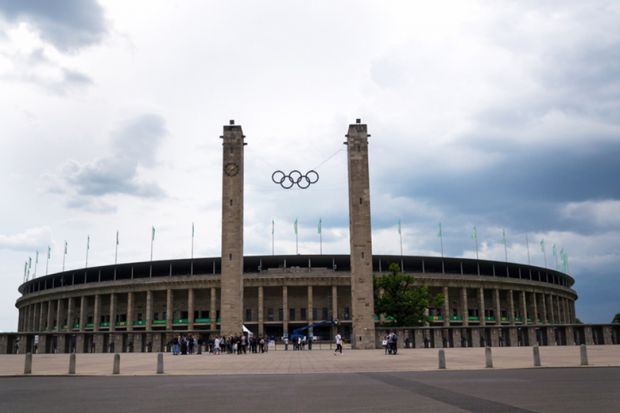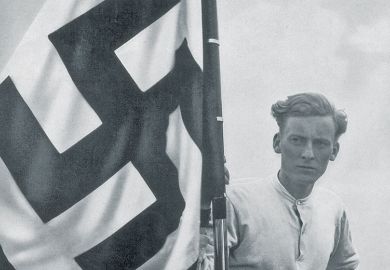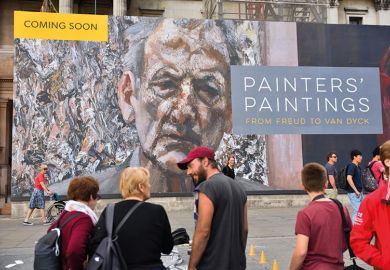Received opinion holds that nothing of artistic worth was produced in Germany under the National Socialist German Workers’ Party. However, persons with optic nerves connected to their brains rather than to some ideology should appreciate the aesthetics of Nazi postage-stamps, the effectiveness and design of posters, the films of Leni Riefensthal, the structures associated with the Autobahnen, the Stadium for the 1936 Berlin Olympics by Werner March and the powerful, though unrealised, commemorative designs by Wilhelm Kreis for memorials to the fallen. And P. L. Troost’s temples of honour (destroyed in 1947), completing the unfinished Königsplatz in Munich, should have been retained for architectural reasons, cleansed of their Nazi associations.
On architectural matters, Kater recognises, with considerable understatement, that many “disciples of the Bauhaus were retained in state-administrative or teaching positions, as they were able to adapt themselves to the [Nazi] regime’s own requirements”, but does not mention that one of them designed part of the extermination camp at Auschwitz-Birkenau. He also admits that Walter Gropius was “clearly pandering to the Nazi regime” in 1933-34. As for Miës van der Rohe, Kater omits the diaeresis as well as his public support for Hitler in the odious Party rag, Völkischer Beobachter. Both these deeply flawed men have been erroneously associated with “democracy” and architecturally greatly overrated, largely because of political manoeuvrings during the Cold War, whereas they were authoritarians. It seems to be an article of faith that anyone who left Germany in the 1930s was somehow superior in cultural terms to those who stayed, but that fastidious commentator, Stefan Zweig, disagreed, disliking whole groups of emigrants, and finding people such as Bertolt Brecht and Hanns Eisler mere hoodlums. After all, the sculptors Arno Breker, Josef Thorak and Arnold Waldschmidt were no mean talents, and Speer’s Chancellery in Berlin (destroyed) was impressive as architecture.
In music, Carmina Burana (1937) by the committed Nazi, Carl Orff, is dubiously described by Kater as “the single universally important work produced during the entire span of the Third Reich”. Pfitzner’s mellifluous Von deutscher Seele, in the 1937 revised version, is a far finer piece, beautifully crafted, and there could be no more sensitive, exquisite, intelligent opera than Richard Strauss’ tender, humorous and dramatically perfect Capriccio (premiered in 1942).
Far too many British commentators have produced admiring effusions about Ernst Jünger, for example, whose writings helped usher in the Nazi era. His glorification of warfare, his totalitarian views and his perverted fascination with decay and extreme violence make him what Kater calls a “sadistic voyeur of inequities and irregularities in nature”, but British critics simply do not get it. The disgusting desensitising scribblings of Josef Martin Bauer, distributed en masse to German forces, may have encouraged barbarities such as the live torching of partisans and the shooting of civilians after they had dug their own graves. There is no doubt that culture in its many forms was brought into service as an aid to the Nazi dictatorship, used to intimidate or encourage, and even to expedite the destruction of perceived enemies. Poisonous “literature”, advertisements and films suggested that Jews were subhuman.
Kater has collected much in this interesting volume, although there are lacunae, especially on the architectural front. The totalitarian state creates singular problems for artists working in any medium, and Kater has outlined some of the many ways in which culture was besmirched and used for propaganda by just one loathsome regime.
James Stevens Curl’s latest book is Making Dystopia: The Strange Rise and Survival of Architectural Barbarism (2018). He recently received an Arthur Ross Award for Excellence in the Classical Tradition for History & Writing by the Institute of Classical Architecture & Art in the US.
Culture in Nazi Germany
By Michael H. Kater
Yale University Press
472pp, £25.00
ISBN: 9780300211412
Published 21 May 2019
POSTSCRIPT:
Print headline: Beautiful face of a brutal regime
Register to continue
Why register?
- Registration is free and only takes a moment
- Once registered, you can read 3 articles a month
- Sign up for our newsletter
Subscribe
Or subscribe for unlimited access to:
- Unlimited access to news, views, insights & reviews
- Digital editions
- Digital access to THE’s university and college rankings analysis
Already registered or a current subscriber?








